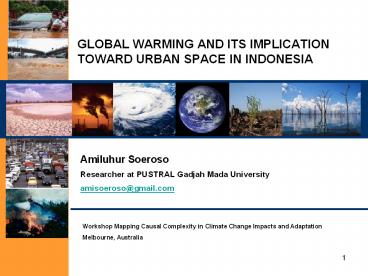GLOBAL%20WARMING%20AND%20ITS%20IMPLICATION%20TOWARD%20URBAN%20SPACE%20IN%20INDONESIA - PowerPoint PPT Presentation
Title:
GLOBAL%20WARMING%20AND%20ITS%20IMPLICATION%20TOWARD%20URBAN%20SPACE%20IN%20INDONESIA
Description:
GLOBAL WARMING AND ITS IMPLICATION TOWARD URBAN SPACE IN INDONESIA Amiluhur Soeroso Researcher at PUSTRAL Gadjah Mada University amisoeroso_at_gmail.com – PowerPoint PPT presentation
Number of Views:236
Avg rating:3.0/5.0
Title: GLOBAL%20WARMING%20AND%20ITS%20IMPLICATION%20TOWARD%20URBAN%20SPACE%20IN%20INDONESIA
1
GLOBAL WARMING AND ITS IMPLICATION TOWARD URBAN
SPACE IN INDONESIA
Amiluhur Soeroso Researcher at PUSTRAL Gadjah
Mada University amisoeroso_at_gmail.com
Workshop Mapping Causal Complexity in Climate
Change Impacts and Adaptation Melbourne, Australia
2
Structure of Presentation
- Introduction
- Current condition of Indonesia
- Adaptation Plan Related to Urban Infrastructure
- Infrastructure Adaptation Strategy
- Closing Remarks
3
Introduction
- Indonesian geographical position ? one of the
most vulnerable nations towards climate change
impact - cities more vulnerable to flood
- rural areas will have fresh water shortages.
- The warming mountain areas widen the habitat for
disease vectors. - high sea level and tidal wave cause abrasion and
threaten coastal settlements.
4
Current Condition in Indonesia (1)
- Spatial planning is aimed at sustainable
development for environmental prosperity - 70 percent of infrastructures development in
Indonesia is centered in Java, Sumatera and Bali
Islands - Infrastructures dispersion is not well-arranged,
that it caused spatial structuring failure - The contribution of urban activities to Green
House Effect (GHE) is about 60 percent - Related to the context of climate change, this
factor worsens the problems of fresh water
provided for urban areas
5
Current Condition in Indonesia (2)
- Illegal logging in highland and thus have
increased erosion, properties and settlements
built in river banks areas causes stream area in
critical condition - 35 thousand hectares of primary and secondary
forestland has conversed to plantation and
settlements every year - Mangrove forest in Indonesia only remains 50
percent or 3.5 million hectares. - The increase of flood intensity caused by global
warming is predicted to be nine times greater in
the next decades
6
Current Condition in Indonesia (3)
- Increasing sea level and flood will threat many
areas - Airports Polonia (Medan), Soekarno-Hatta
(Jakarta), Juanda (Surabaya), Ngurah Rai
(Denpasar), Hassanudin (Makassar) and Ahmad Yani
(Semarang). - Harbours Belawan (Medan), Tanjung Priok
(Jakarta), Tanjung Mas (Semarang), Tanjung Perak
(Surabaya), Pontianak and Makassar. - Road along of eastern Sumatera, northern Java
(Jakarta-Surabaya) and central Sulawesi
(Pare-pare-Bulukumba via Makassar). - Irrigation network at food area centre of
northern Java, eastern Sumatera and southern
Sulawesi.
7
Adaptation Plan Related to Urban Infrastructure
- Holistic (ecological) planning is required in
adaptation plan (Keraf, 2002) - facts cannot be separated from values
- the use of synergy systemic relation
- in making policy, comprehensive consideration to
the aspects of value, culture, economic benefit,
etc. is taken into account - The characteristics of holistic paradigm are
(Howitt, 2001). - the balance proportion between the central and
local authorities - multidimensional views
- Cooperation
- attention to varieties and integration
- comprehensive development.
8
Conceptual Framework For Urban Infrastructure
Adaptation
9
Infrastructure Adaptation Strategy (1)
10
Infrastructure Adaptation Strategy (2)
11
Infrastructure Adaptation Strategy (3)
12
Infrastructure Adaptation Strategy (4)
13
Closing Remarks (1)
- In changing the context of the future spatial
planning in Indonesia, the growth measurement
should be shifted to holistic development - Sustainable economic development can be achieved
when the balance in ecological functions is
maintained - Involve local community
- Appropriate spatial planning needs to be
conducted by referring to Bali agenda road map
14
Closing Remarks (2)
- The adaptation efforts to climate change require
- international cooperation to support the actions
- risk management and risk reduction strategy
- diversification in the economic sector to build
resilience. - Challenges in the implementation of spatial
governance - the needs of improvement in all related sectors
- the technical and methodological aspects
- the capacity and interests of the stakeholders
- the most crucial one, funding.
15
- THANK YOU

